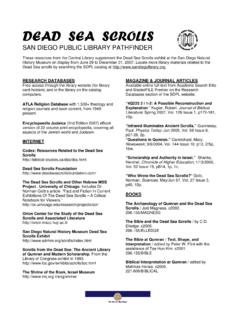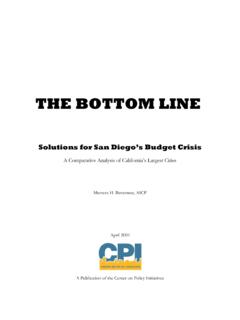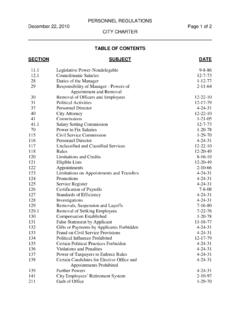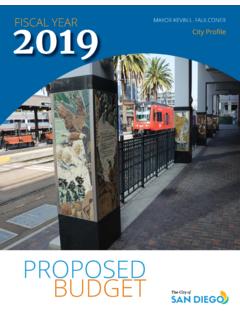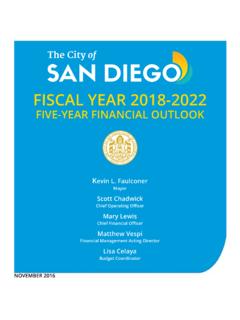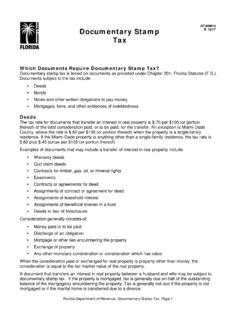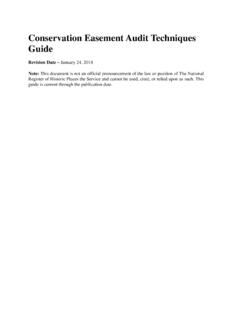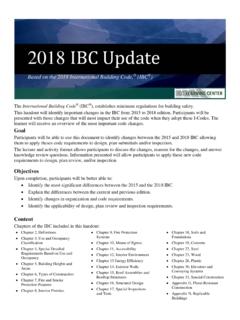Transcription of Volume I, Chapter 1 Project Submittal Requirements
1 MARCH 2021. LAND DEVELOPMENT MANUAL. Volume I, Chapter 1. Project Submittal Requirements Section 1. Guide to Project Submittal Process DEVELOPMENT SERVICES DEPARTMENT. Visit our web site at March 2021. Table of Contents Guide to the Project Submittal Process Important Steps to Project Approval .. 1-1. 1. Determine the zoning designation of your 1-1. 2. Determine what uses are allowed on your property .. 1-1. 3. Identify regulations governing the size and scale of development .. 1-2. 4. Identify other development regulations that apply to your 1-2. 5. Determine if your property contains environmentally sensitive 1-2. 6. Determine if your property contains historical resources .. 1-2. 7. Geologic 8. Identify model code Requirements .. 1-3. 9. Determine the type of permit or approval 1-3. 10. Determine the decision process .. 1-4. 11. Determine the review process .. 1-4. 12. Determine the Project Submittal Requirements and schedule your Submittal appointment .. 1-6. 13. What happens next?
2 1-6. Optional Project Review Services .. 1-7. Project Submittal Requirements .. 1-8. Permit/Approval Table .. 1-9. March 2021. 1. Section P R O J E C T S U B M I T T A L R E Q U I R E M E N T S. Guide to the Project Submittal Process Important Steps to Project Approval L A N D D E V E L O P M E N T M A N U A L P R O - F. J E C T S U B M I T T A L P R O C E S S. ollowing the basic steps listed below will assist you in completing your Project Submittal package and help Section 1 Guide to the Project Submittal Process lead you to a successful Project approval. To deter- Section 2 Construction Permits Structures mine the City of San Diego's planning, zoning, subdivision, Section 2A Single Dwelling Unit/Duplex/Townhomes and/or building regulations that apply to your Project , you and Accessory Structures must obtain the Parcel Information (DS-302). By evaluat- Section 3 Construction Permits - Grading and Public ing this information PRIOR to designing your Project , you Right-of-Way can avoid mistakes early in the process, save time, and Section 4 Development Permits/Approvals reduce processing costs.
3 Section 5 Subdivision Approvals Section 6 Policy Approvals This information can be obtained by emailing the request users conveniently access real-time information from their to or through Zoning and Par- computer or mobile device 24 hours a day, seven days a cel Information Portal (ZAPP). week. NOTE: Project Submittal Requirements (Section 2-6) re- quires all parcel information to be on the plans. The Official Zoning Maps were adopted by Council on Feb- ruary 28, 2006 and currently only represent base zone in- Important Note: formation. In the future, it is intended the maps will also provide overlay zone and Planned District information. Other permits, approvals, and fees may be required Until then it is recommended you request confirmation of from outside agencies that are not handled by the City your zoning using one of the methods listed below. of San Diego Development Services Department, school districts, public utilities, County Health. Con- Base zones govern the uses permitted and the develop- tact the appropriate agency for information on their ment regulations of the site.
4 Once you have determined procedures. the base zone, refer to Land Development Code Chapter 1. Determine the zoning designation 13, Article 1, Divisions 1-6 for your property development regulations. If your property is in a Planned District, refer of your property to Chapter 15. A Planned District is a legally described ge- Zoning is the legislative method by which land use, inten- ographic area which has been designated by the City Coun- sity of development, site design, and architectural design cil and adopts different development controls than city- are controlled. Some zones apply to all or many parts of wide base zones. the City while other zones, such as those within Planned 2. Determine what uses are allowed Districts, apply only to very specific sections of the City. on your property Overlay Zones are another type of zoning that may add After you have determined your zoning, refer to Municipal special regulations to the underlying zone. To research Code Chapter 13, Article 1, Divisions 1-6 to find the uses zoning and property information visit the Zoning and Par- permitted in each zone.
5 Divisions 2-6 contain use regula- cel Information Portal (ZAPP). This online service helps tions tables that list the permitted uses for each zone, uses March 2021. Section 1- Page 1. P R O J E C T S U B M I T T A L R E Q U I R E M E N T S. that are allowed with specified limitations, and uses that If your property contains environmentally sensitive lands require a use permit. If your property is located within an and you do not qualify for exemption pursuant to Munici- overlay zone, you will also need to refer to Chapter 13, pal Code Section (c), you will need to obtain either Article 2 to find any supplemental regulations. If your a Neighborhood Development Permit or a Site Develop- property is in a Planned District, refer to Chapter 15 for ment Permit. To determine which type of permit you need permitted uses. refer to Table 143-01A Applicability of Environmentally 3. Identify regulations governing the Sensitive Lands Regulations in Municipal Code Section size and scale of development To find the basic development regulations that apply to If you can qualify for an exemption pursuant to Municipal your site, refer to the development regulations tables in Code Section (c), you will not be required to ob- Municipal Code Chapter 13, Article 1, Divisions 2-6.
6 These tain either a Neighborhood or Site Development Permit. If regulations govern the size and scale of development and the exemption you qualify for is (c) (1), you will be include Requirements for lot size, setbacks, structure required to provide a statement on the site or grading plan height, and permitted density. Each division contains a signed by the property owner acknowledging that the de- development regulations table that lists the basic devel- velopment activity will not encroach into the environmen- opment regulations for each base zone. The tables also tally sensitive lands during or after construction and that refer to other sections in the Municipal Code that contain further development on the property is not permitted un- additional regulations that are applicable in the base less the development is reviewed and approved pursuant zone. If your property is in a Planned District, refer to to Chapter 14, Article 1, Division 1 of the Municipal Code.. Chapter 15 for property development regulations.
7 4. Identify other development regula- 6. Determine if your property contains tions that apply to your property historical resources Once you have found the use and development regula- a. Potential Historical Resource: If the Project site con- tions for your base zone and any overlay zones, if appli- tains a structure that is 45 or more years old AND is cable, look in Municipal Code Chapter 14 for additional not a designated Historic Site, Structure or in a Historic city-wide, general development regulations that apply in District, see Information Bulletin 580 (Potential Histor- all zones. All development is subject to the general devel- ical Resource Review) for additional Submittal and re- opment regulations in Chapter 14, Article 2, whether or view Requirements . not a permit or other approval is required. This article includes regulations for grading, drainage, fences, land- b. Designated Historical Site or District: If the Project scaping, parking, equipment screening, loading areas, site or structure is designated Historical OR located outdoor storage, and signs.
8 If the regulations require that within a Historical District, see Information Bulletin you obtain a permit for certain types of development, an 581 (Designated Historical Resource Review) for re- applicability table will refer you to the appropriate sec- view Requirements . tions within each division for the type of construction or development permit needed. 7. Geologic Hazards Geologic conditions exist within the City of San Diego that 5. Determine if your property con- can pose serious problems when land is developed. Un- tains environmentally sensitive stable slopes, slide-prone geologic formations, faults, and liquefaction-prone soils occur in many parts of the City. lands Geologic conditions within the City have been categorized Environmentally Sensitive Lands include sensitive biolog- and the relative risk of hazards have been mapped as part ical resources, steep hillsides, sensitive coastal bluffs, City of San Diego Seismic Safety Geologic Hazards and coastal beaches, and special flood hazard Faults Maps.
9 These generalized maps may be used in con- areas. If you are developing property that contains Envi- junction with Information Bulletin 515 and San Diego Mu- ronmentally Sensitive Lands, refer to Municipal Code nicipal Code to determine when site-specific ge- Chapter 14, Article 3, Division 1 for the supplemental reg- otechnical investigation reports are required for Submittal ulations. with proposed development and construction plans. Infor- mation on geotechnical reports is provided in the City's If any portion of your property contains environmentally Guidelines for Geotechnical Report. sensitive lands, you will be required to provide more in- formation to assist City staff in determining the type of permit you will need. Section 1- Page 2. March 2021. P R O J E C T S U B M I T T A L R E Q U I R E M E N T S. 8. Identify code Requirements Project . If a Development Permit/Approval is re- quired, it must be approved before a Construction The California Codes are adopted and modified by the Permit can be issued.
10 City of San Diego to safeguard life, health, property and public welfare. The provisions of these codes apply to the construction, alteration, moving, removal, demolition, re- pair, conversion, maintenance and use of all buildings or Subdivision Approvals: structures in the City of San Diego. The codes adopted by Subdivision approvals regulate the division of lands the City of San Diego are: and the associated design of improvements, and the California Building Code acquisition and vacation of public rights-of-way and California Mechanical Code public easements with the City. Some subdivision ap- California Plumbing Code provals are administrative and do not require a public California Fire Code hearing. Some are discretionary and require a public California Electrical Code hearing. California Energy Code California Historic Code Policy Approvals: California Residential Code Policy approvals involve requests to amend existing California Green Building Standards Code City policies such as changing the zoning designation of a site or amending a community plan.
